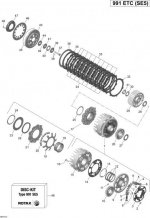rcturner
New member
BRP has known about the weak/slipping clutch since 2009, and put a new clutch in all Spyders since 2011. I bought my 2009 Spyder brand new and they replaced/upgraded a clutch under warranty, it was never a Recall but a well-known issue. Sunshine riders who never open the throttle will never even notice before their clutch slowly and surely smoke itself off - when the warranty is gone.
Based on the first response above, the new clutch was incorporated in 2011. There must still be some kind of weakness that has caused them to redesign and include the nozzle change in the 2013 model after having the new clutch for two model years. What are we missing?
Not sure how necessary it is, it is something that is part of the new clutch pack.
Based on the first response above, the new clutch was incorporated in 2011. There must still be some kind of weakness that has caused them to redesign and include the nozzle change in the 2013 model after having the new clutch for two model years. What are we missing?
Last edited by a moderator:

